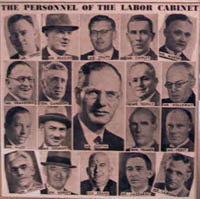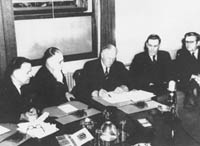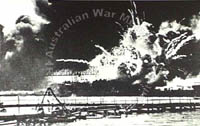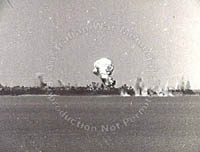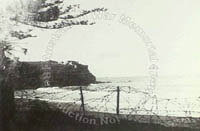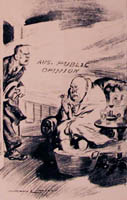
When the office of Prime Minister was suddenly thrust upon a reluctant John Curtin on 7 October 1941, the Pacific War was about to explode on Australia's doorstep.
The bombing of Pearl Harbor on 7 December marked the beginning of a rapid Japanese offensive. Fearing the worst, Australians prepared for invasion.
CURTIN BECOMES PRIME MINISTER
Since 1931, the United Australia Party had governed Australia with the support of the Country Party. In August 1941, following growing unrest within the coalition government, Country Party leader Arthur Fadden replaced Robert Menzies as Prime Minister.
Soon after, the two independent members who held the balance of power in the House of Representatives voted against the government's budget and the coalition was defeated. Curtin was appointed Prime Minister on 7 October 1941.
Without a majority in either house of Parliament, his Labor government was in a precarious position. Although he had been Leader of the Opposition since 1935, he had never served in government.
A man of peace had suddenly found himself called upon to lead Australia in a time of war.
Japanese
air raid on Pearl Harbor,
Hawaii, 7 December 1941. Australian War Memorial Negative No 043822.
AUSTRALIA PREPARES FOR INVASION
On 7 December 1941, the Japanese launched a surprise attack on Pearl Harbor in Hawaii. The United States, previously a neutral nation, immediately declared war on Japan. Australia followed suit.
Within 24 hours, the Japanese offensive through South-East Asia had begun with landings in Malaya and Thailand. On 15 February 1942 the British colony of Singapore, seen by many as the last bastion between Australia and the advancing enemy, fell to the Japanese.
Japanese
troops advancing
in Malaya, 1943. Australian War Memorial Negative No 127894.
The
first Japanese air raid on Darwin
Harbour, 19 February 1942. Australian War Memorial Negative No 012953.
Four days later Darwin was bombed. A series of air raids on Broome and Wyndham in Western Australia and further attacks on Darwin sent shock waves through the country. Australians, standing virtually unprotected in the face of the Japanese onslaught, feared outright invasion.
'AUSTRALIA LOOKS TO AMERICA'
'Without any inhibitions of any kind I make it quite clear that Australia looks to America, free of any pangs as to our traditional links or kinship with the United Kingdom.` John Curtin's dramatic appeal in a Melbourne Herald article of 26 December 1941 caused controversy across the world. For some it meant a disloyal rejection of Britain; for others a bold recognition of Australia's desperate position.
Sydney's
Manly Beach protected
from potential invaders by barbed
wire, 1942. Australian War Memorial Negative No 044546.
THE CONTROVERSY
Curtin's striking statement was plucked from an otherwise routine article in which he appealed to Australians to support the war effort. British Prime Minister Winston Churchill claimed that the statement would `cause resentment throughout the Empire'. US President Franklin Delano Roosevelt said it `tasted of panic and disloyalty'. Yet newspapers across the country supported Curtin's declaration.
THE CONSEQUENCES
The United States did come to Australia's aid, but it is unlikely that Curtin's statement had a major impact on US military strategy. A close alliance between the two countries was probably inevitable, as they both shared the same goal - to defeat the Japanese.
American
armoured cars in a
Melbourne street parade. National Library of Australia Aust-Defence-WWII.
GENERAL MACARTHUR
US General Douglas MacArthur was appointed Supreme Commander of the South West Pacific region in March 1942. He arrived in Australia to a hero's welcome on 17 March. Curtin and MacArthur developed such a close relationship that some critics have accused Curtin of handing the reins of power over to the American General.
US soldiers at the American Red Cross
building in Mackay, Queensland. Australian War Memorial Negative No 044812.
THE COMING OF THE AMERICANS
Following MacArthur's arrival, Brisbane became the headquarters of the US military campaign in the Pacific. Hundreds of thousands of US troops poured into Australia. Referred to by disgruntled local men as 'over-sexed, over-paid and over here', the American troops made their presence felt across the country.
RECALLING THE TROOPS
In early 1942 Curtin clashed with British Prime Minister Winston Churchill over the use of Australian troops overseas. Curtin's insistence that his troops return home to protect Australian soil was seen as a brave stand against a powerful ally. His personal anguish over the safety of the returning troops has become part of Australian folklore.
Southerly Buster cartoon by Norman Lindsay. The Bulletin, 4 February 1942, page 5.
WAS CURTIN RIGHT?
Rangoon, the capital of Burma, fell to the Japanese on 8 March 1942. Most war historians consider it unlikely that the 6th and 7th Divisions could have saved the city if Curtin had agreed to their diversion. After their return to Australia in March, many of the troops fought in successful campaigns to repel the Japanese advance through New Guinea and Borneo.
OPPOSING CHURCHILL
During January and February 1942, the 6th and 7th Divisions of the Second Australian Imperial Force were sailing from the Middle East to protect British interests in the Dutch East Indies. After the fall of Singapore on 15 February 1942, Curtin asked Churchill to send the troops home to defend Australia from the steadily advancing Japanese. Instead, Churchill diverted the 7th Division towards Burma without first seeking Australian approval. Curtin was outraged. Top secret cables flashed between the two leaders. On Curtin's insistence, the ships were turned away from Burma and Churchill finally agreed to their return to Australia.
While the troop ships headed for home across the Indian Ocean, vulnerable to Japanese attack, Curtin waited anxiously. He felt personally responsible for the safety of the thousands of men on board, and could not rest until the troops arrived safely in March 1942.
A REJECTION OF BRITAIN?
In the years since World War II, Curtin's appeal to America has been seen as the genesis of Australia's alliance with the United States. His clash with Churchill has been hailed as a milestone on Australia's road to true independence. Just how significant were these episodes?
Curtin's vision of the post-war world included a strong British Commonwealth, but one in which Australia was an equal partner with special responsibilities for her region. By appealing to the USA, he recognised that Britain was unable to help Australia while battling for its own survival in Europe. By standing up to Churchill, he ensured that Australian interests were not overridden by Britain. Curtin's actions did not mark a sharp break with Britain, nor a sudden and permanent shift of allegiance to the United States. Instead, they marked another step in Australia's continuing search for its place in the world.
